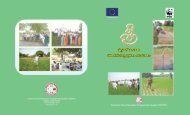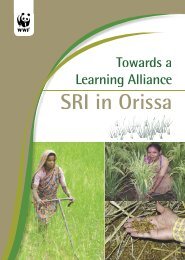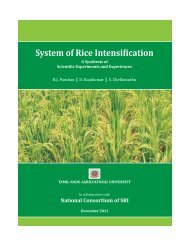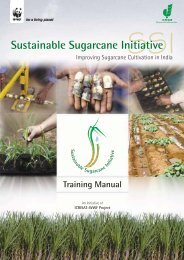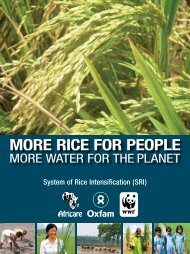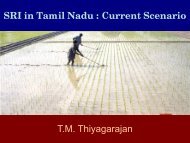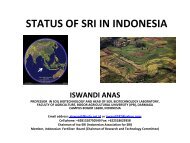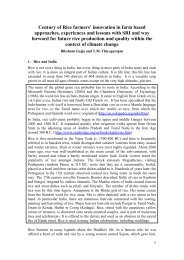SSI Newsletter - SRI - India
SSI Newsletter - SRI - India
SSI Newsletter - SRI - India
You also want an ePaper? Increase the reach of your titles
YUMPU automatically turns print PDFs into web optimized ePapers that Google loves.
<strong>SSI</strong> field interventions in<br />
Nayagarh District of Orissa<br />
Though the farmers of Orissa have been into sugarcane cultivation<br />
for a long time now, <strong>SSI</strong> is a new arena into which these farmers are<br />
stepping in with caution but also happiness in their hearts. Below is<br />
the intervention of ICRISAT-WWF in extending the necessary technical<br />
support for better yields and profits for sugarcane farmers in the state.<br />
Sraban Kumar Dalai and Arundhati Jena<br />
SugarCane<br />
matters<br />
18<br />
Nov ‘09<br />
Overview<br />
Nayagarh district covers 3,890 sq. km.<br />
of the geographic area with 41% of<br />
the forest area, with a population of<br />
8, 64,516 and with an annual normal<br />
rainfall of 1449.1 mm.<br />
There are six sugar mills in Orissa<br />
which are in operation, including the<br />
Nayagarh Sugar Complex Pvt. Ltd<br />
in Nayagarh. Now, according to the<br />
State Government and Team Orissa (a<br />
State Government agency working on<br />
industrial promotion) Report, there<br />
are going to be 14 sugar projects<br />
in the state. Also, it is interesting to<br />
note that the paddy area has been<br />
increasingly diverted to non-paddy<br />
crops during the years 2005, 2006 and<br />
2007 in the state. Sugarcane is one<br />
of the preferred crops for diversion,<br />
replacing paddy. Area diverted<br />
to sugarcane crop during kharif<br />
season was 12,792, 4,244 and 5,836<br />
hectares in the above mentioned<br />
years respectively. If the statistics of<br />
sugarcane area and productivity in<br />
Nayagarh district were to be observed<br />
for the last 8 years, it shows that the<br />
yield hovered between 50 and 70 t/<br />
ha. And there was no improvement<br />
in yield beyond 70 t/ha, even though<br />
the area under sugarcane has more<br />
than doubled!<br />
A Sustainable Sugarcane Initiative<br />
(<strong>SSI</strong>) training was organized along<br />
with practical demonstrations at<br />
WWF-ICRISAT, followed by a field<br />
visit on January 20-21, 2009. Four<br />
farmers from Nayagarh district of<br />
Orissa attended it. Apart from these<br />
trainees, 15 other farmers also got<br />
motivated by the <strong>SSI</strong> methods.<br />
They are all marginal and small<br />
land holding sugarcane farmers.<br />
A total of 4 acres were brought<br />
under cultivation using this method<br />
in Biruda, Ikiri, Tipura villages of<br />
Nayagarh district with the support<br />
of NIRMAN, a local NGO.<br />
The materials used for raising nursery<br />
like bud chipper, shade net shed, trays<br />
and a small quantity of coco-pith<br />
were provided through the WWF-<br />
ICRISAT project to kick start the<br />
<strong>SSI</strong> adoption in Orissa. In the initial<br />
period, farmers used decomposed<br />
sawdust, coir waste, vermi-compost,<br />
etc., for raising a nursery in the 1.3<br />
acre land in their backyard. Some<br />
problems were encountered here due<br />
to ant, termite and rat infestation.<br />
Later, coco-pith was prepared at<br />
the NIRMAN office by mixing coir<br />
waste and vermi-compost. During<br />
the months of February and March,<br />
farmers started raising a nursery in<br />
the backyard of the NIRMAN office,<br />
under the supervision of their staff.<br />
The nursery seedlings were healthy<br />
and the transplantation was done<br />
during the last week of March and<br />
first week of April. During that time,<br />
three farmers initiated intercropping<br />
with the lady’s finger (Bhendi or<br />
Okra) crop.<br />
Results<br />
Presently, the <strong>SSI</strong> crops in the fields<br />
are 6 – 8 months old. The cane<br />
varieties planted are 6907 (local),<br />
Asika (local) and 86 R 97. The number<br />
of tillers varies from 6 to 12 per clump,<br />
the girth of canes varies from 3.8 to 5<br />
inches, and the height of canes varies<br />
from 1.6 to 2.6 metres.<br />
6000<br />
5000<br />
4000<br />
3000<br />
2000<br />
1000<br />
0<br />
1999-00 2000-01 2001-02 2002-03<br />
Yield (t/ha)<br />
Area (in ha)<br />
2003-04 2004-05 2005-06 2007-08<br />
80<br />
70<br />
60<br />
50<br />
40<br />
30<br />
20<br />
10<br />
0<br />
Future plans<br />
NIRMAN has conducted meetings<br />
in two villages of Khairapati and<br />
Gopalpur where 7 farmers from the<br />
former village agreed to go for <strong>SSI</strong><br />
in 3 acres and 30 farmers from the<br />
latter village agreed to go for it in<br />
7.5 acres. Subsequent meetings<br />
are planned in the remaining 12



